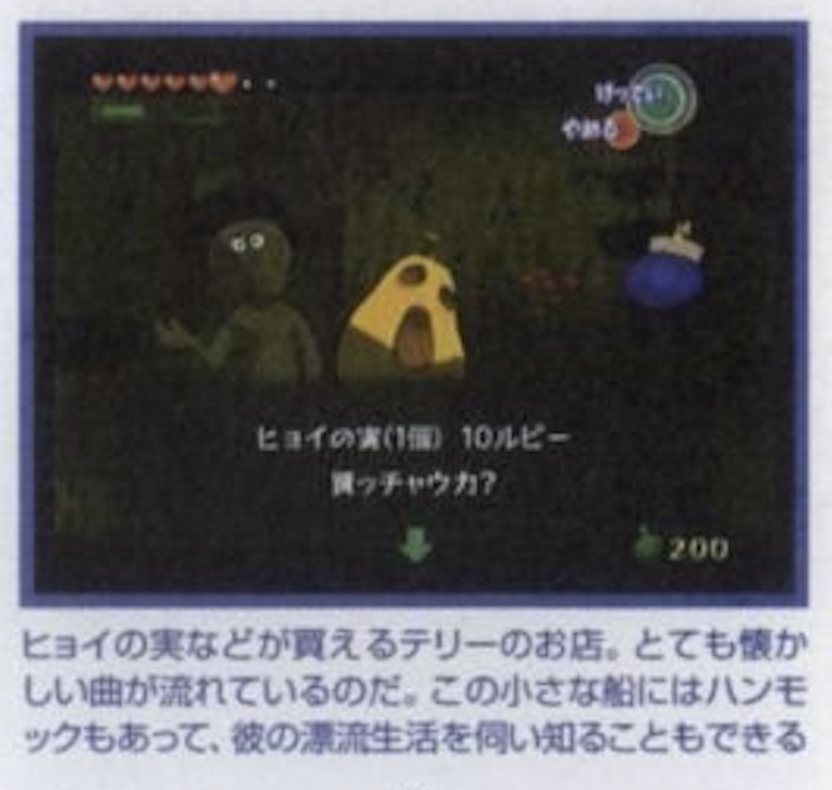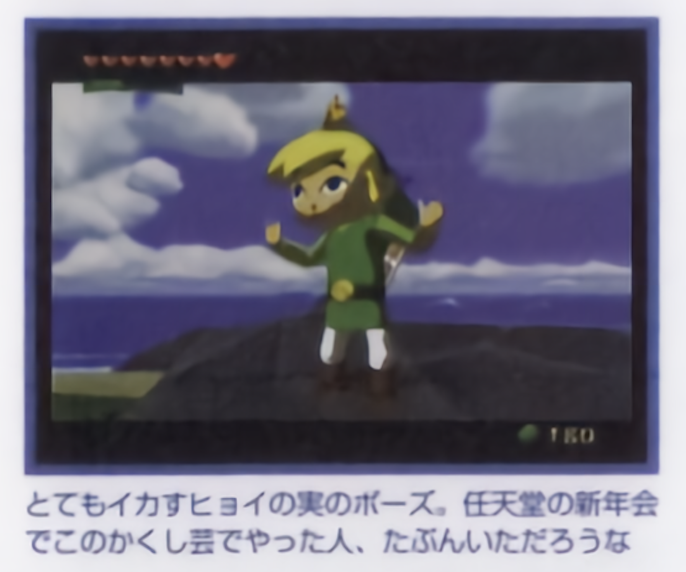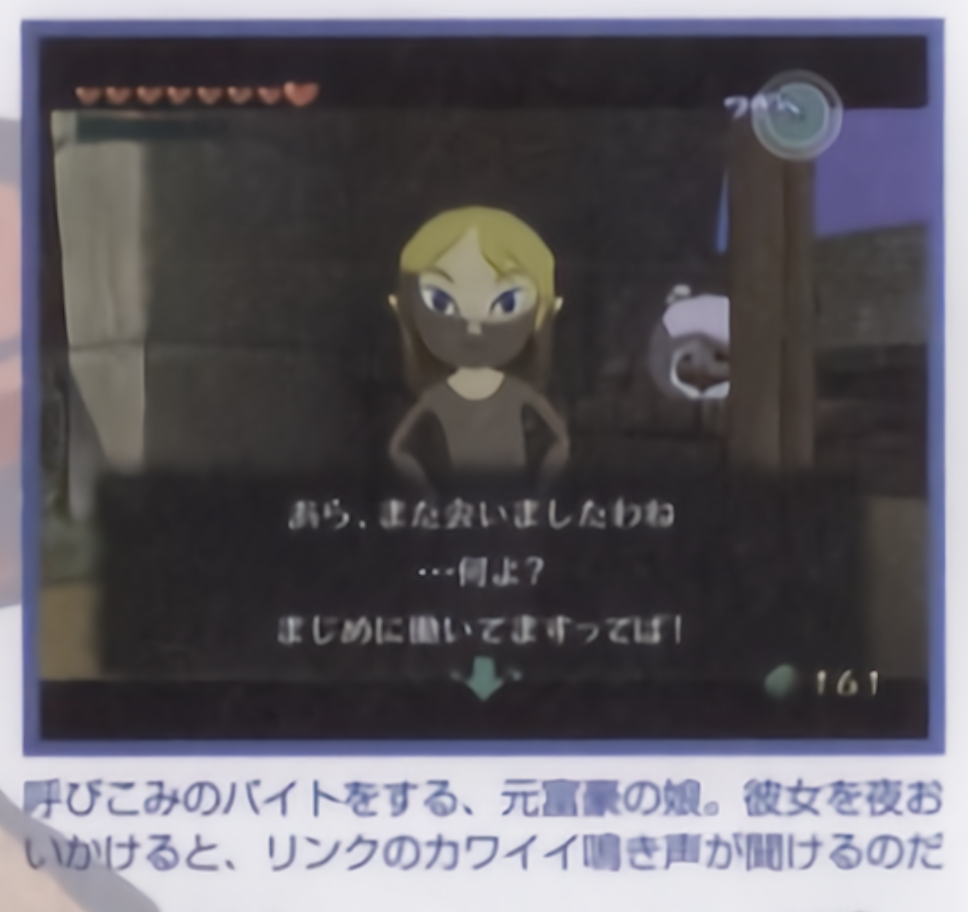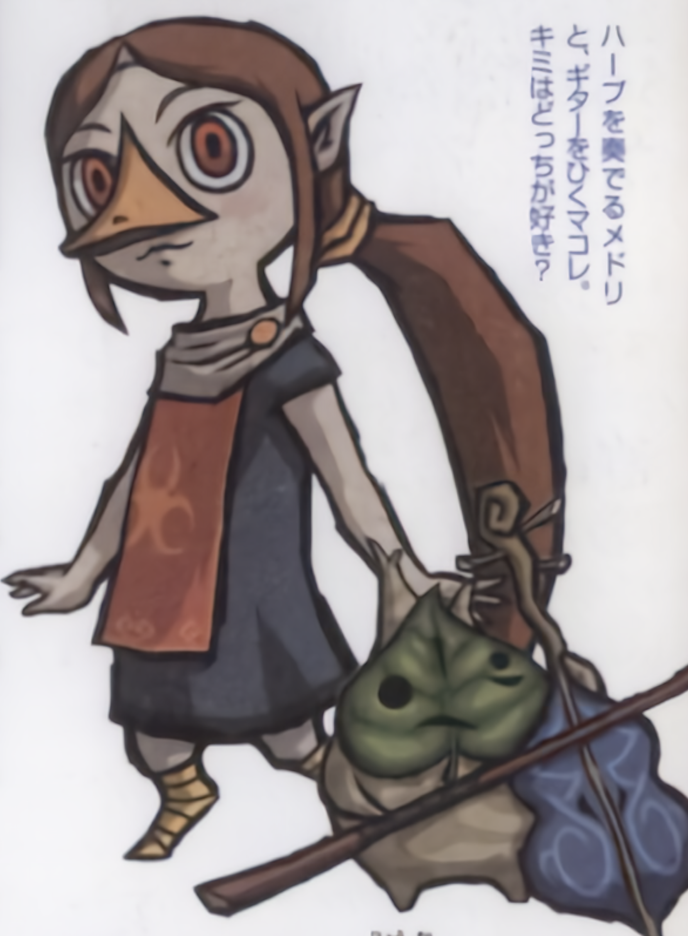This massive developer interview was from Nintendo Dream issue #83 from 2003.
These scans have been upscaled so please feel free to save them and use them however you want.
Translated by
Katrina Scialdone: https://twitter.com/KatrinaKitten__
Roryj: https://twitter.com/RoryJWhelan
Formatted by
Javed Sterritt: https://twitter.com/JavedLSterritt
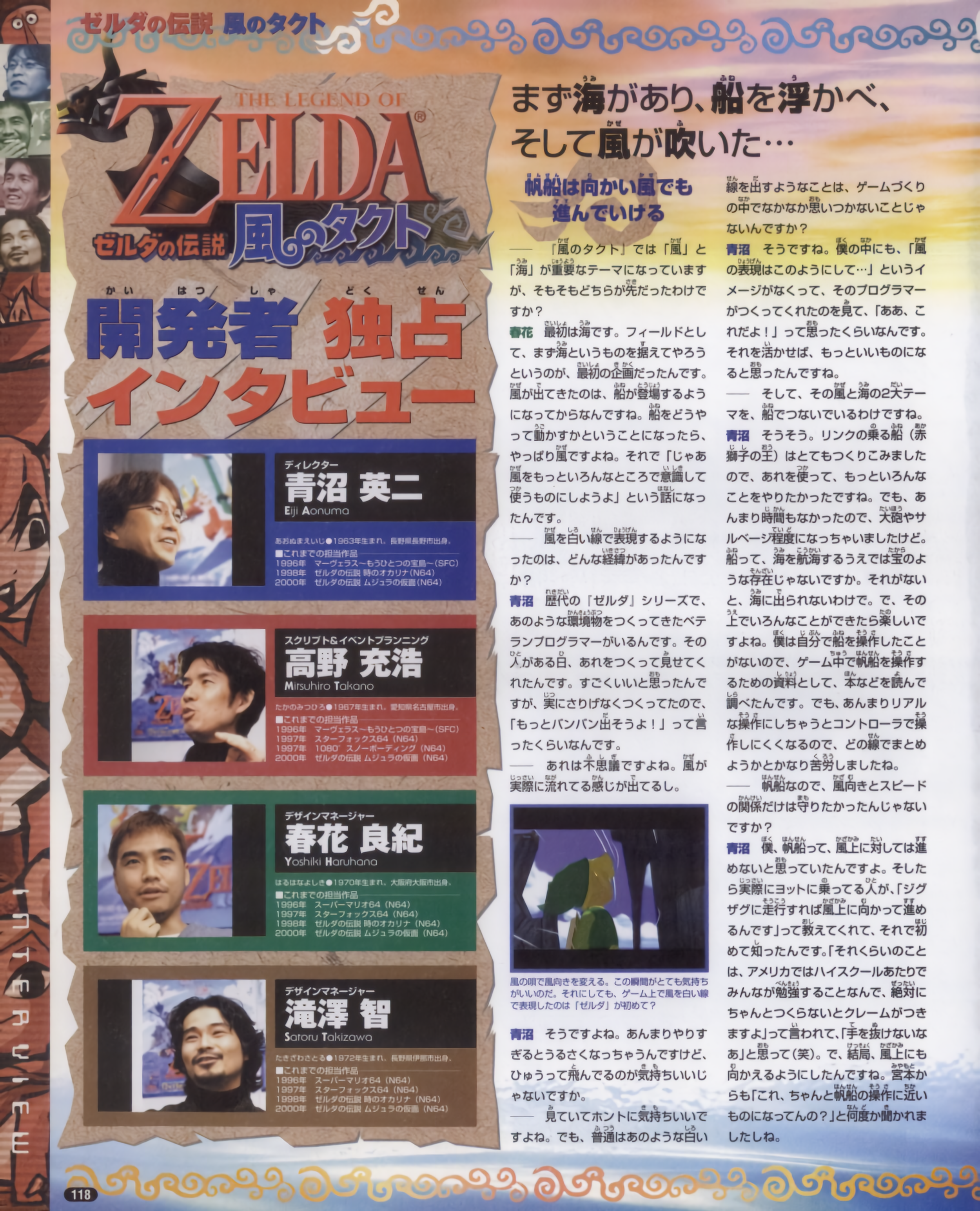
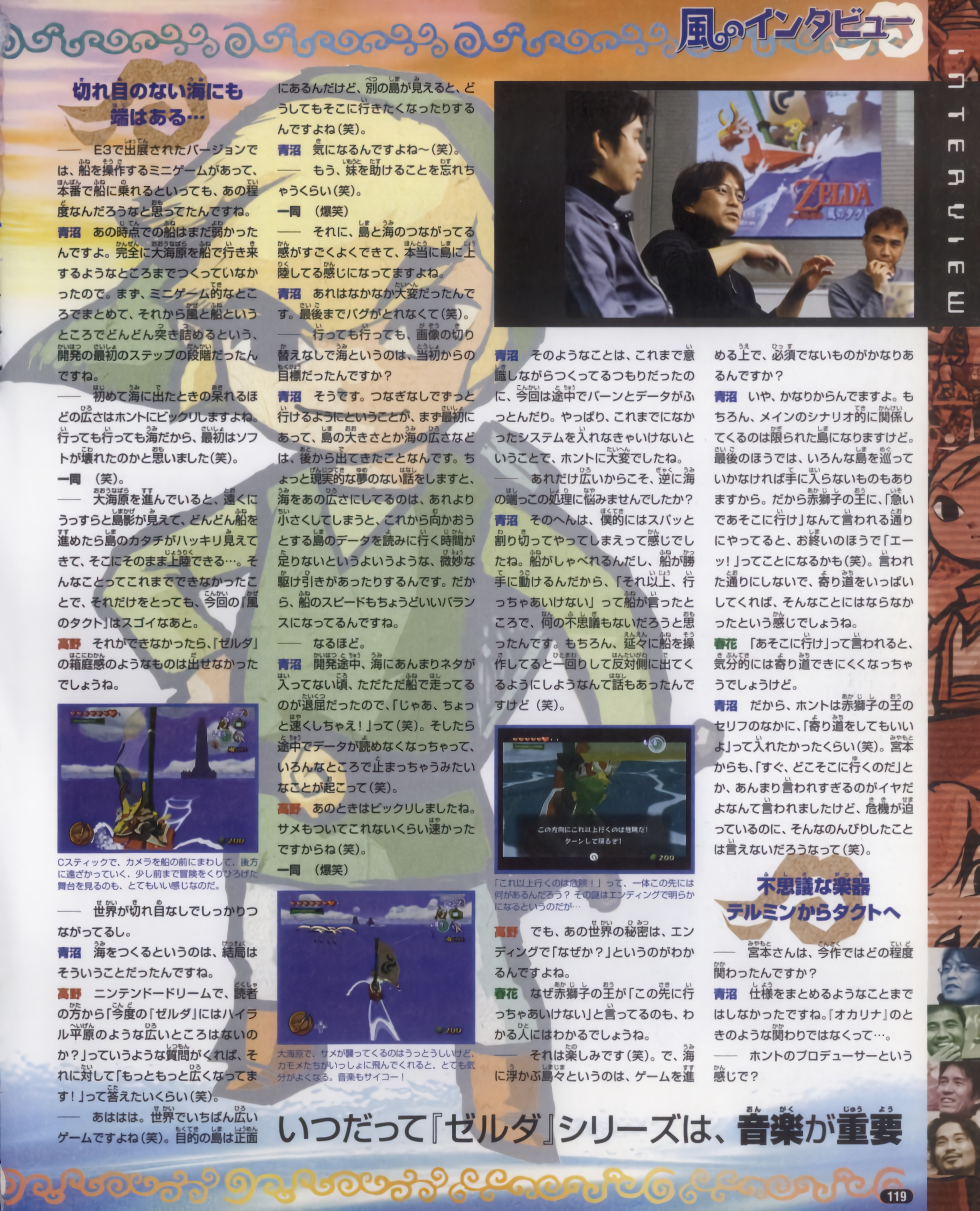


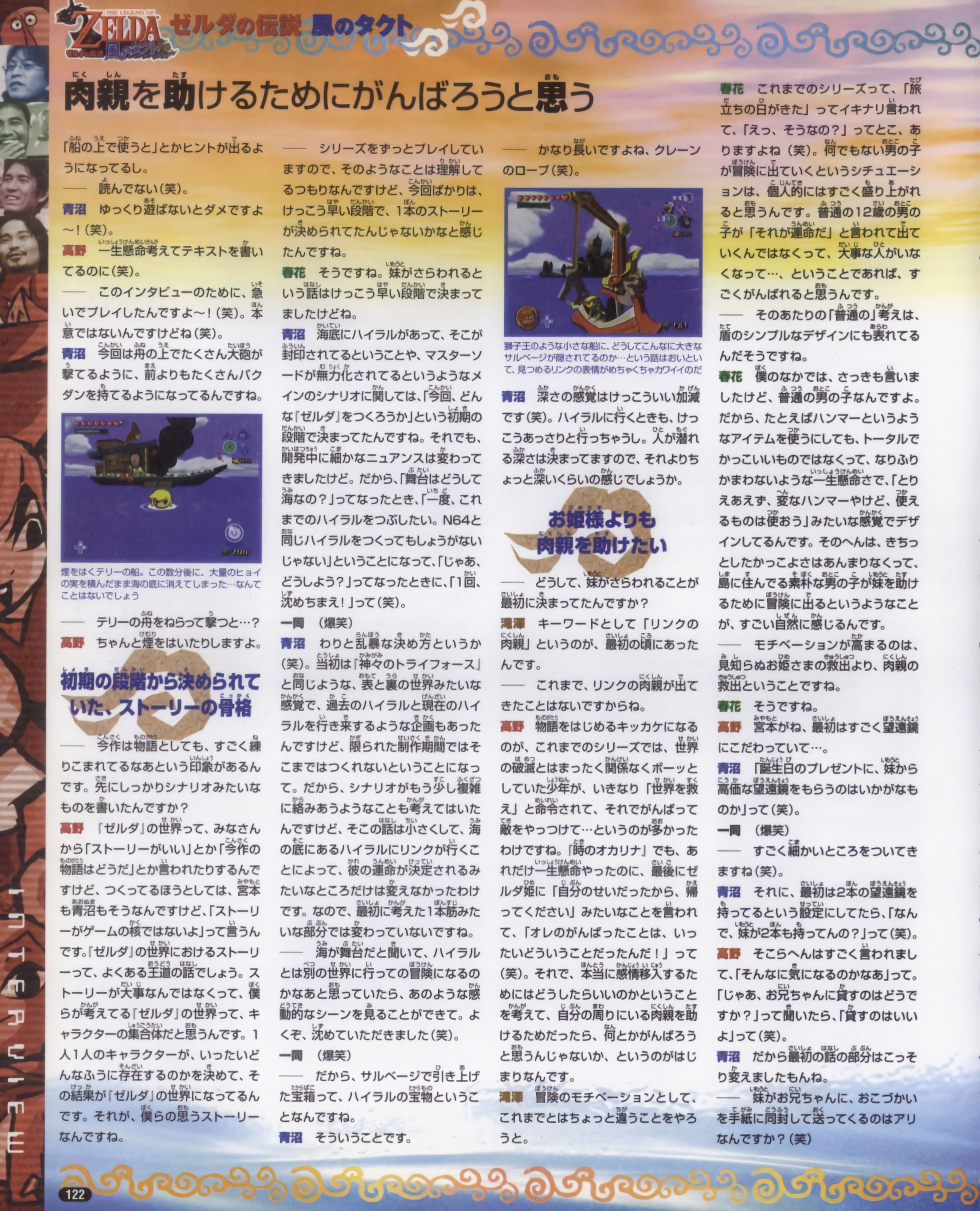
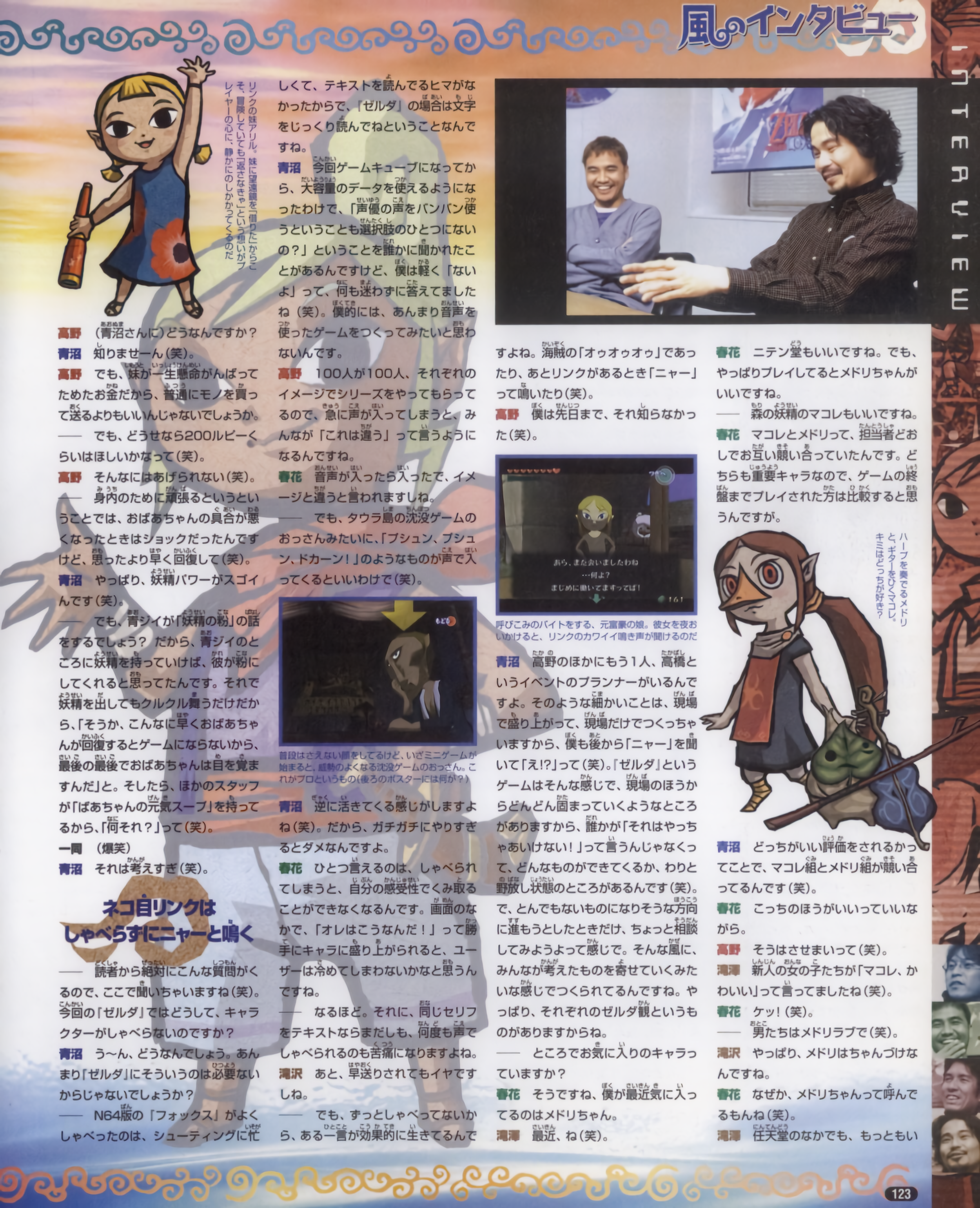
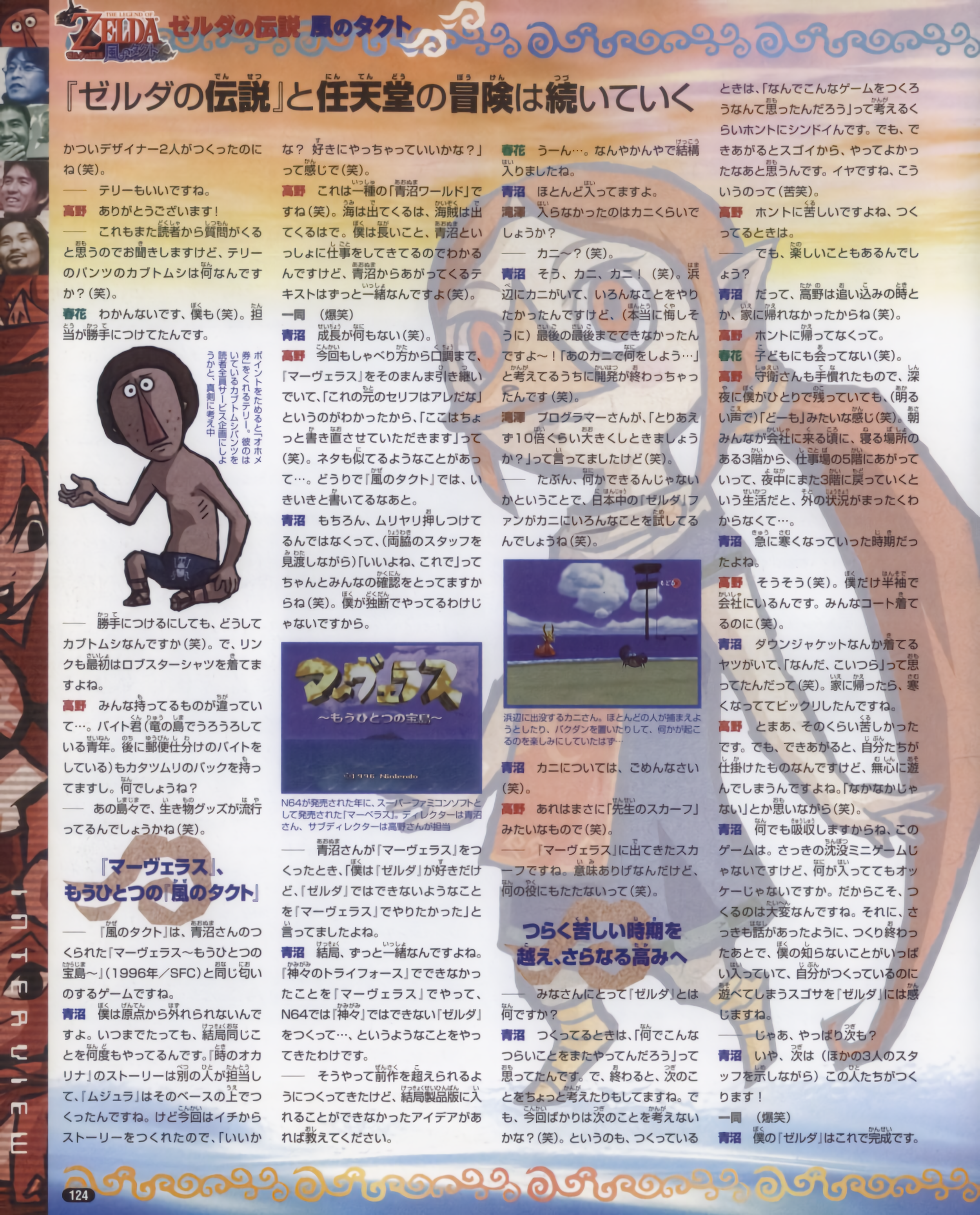
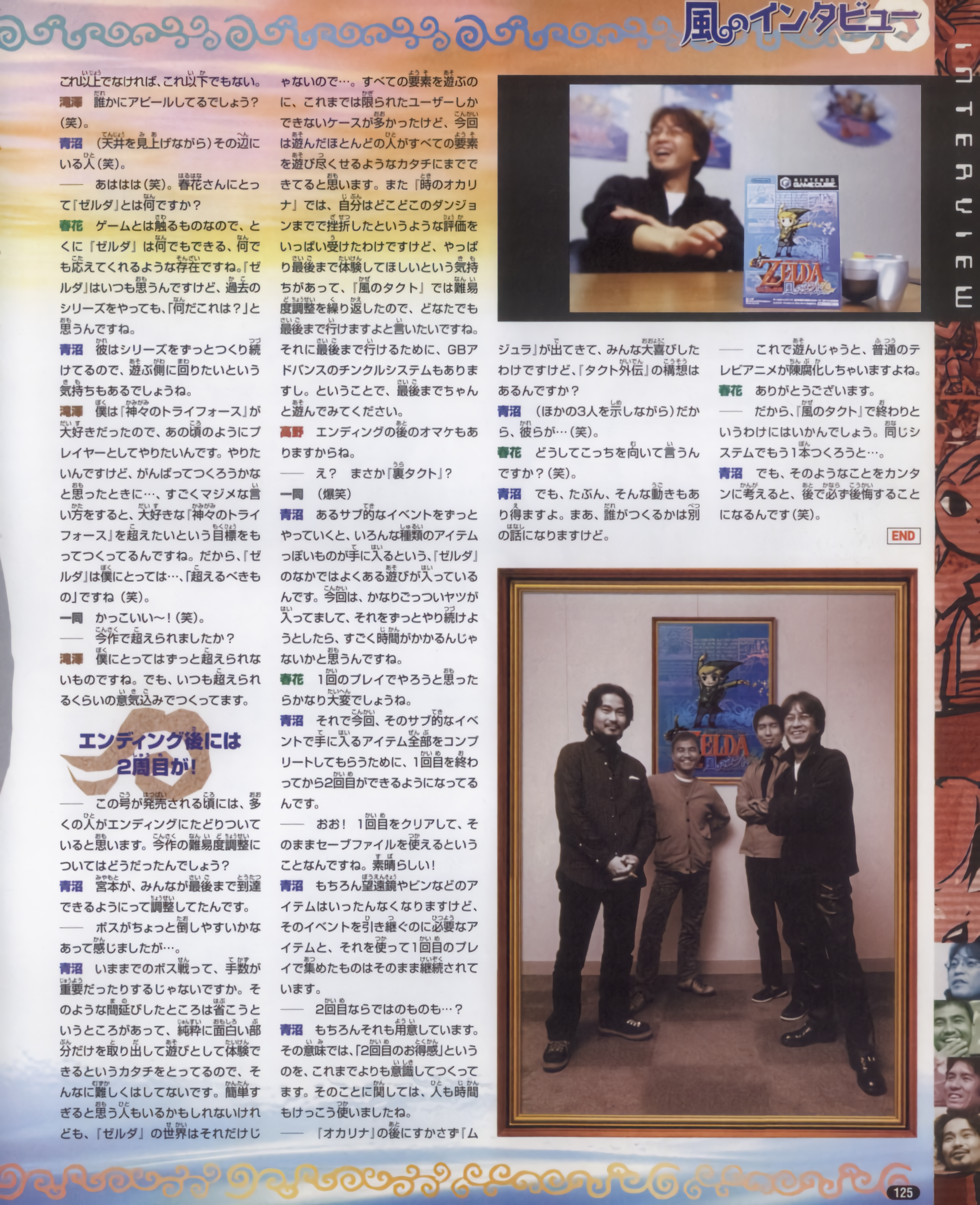
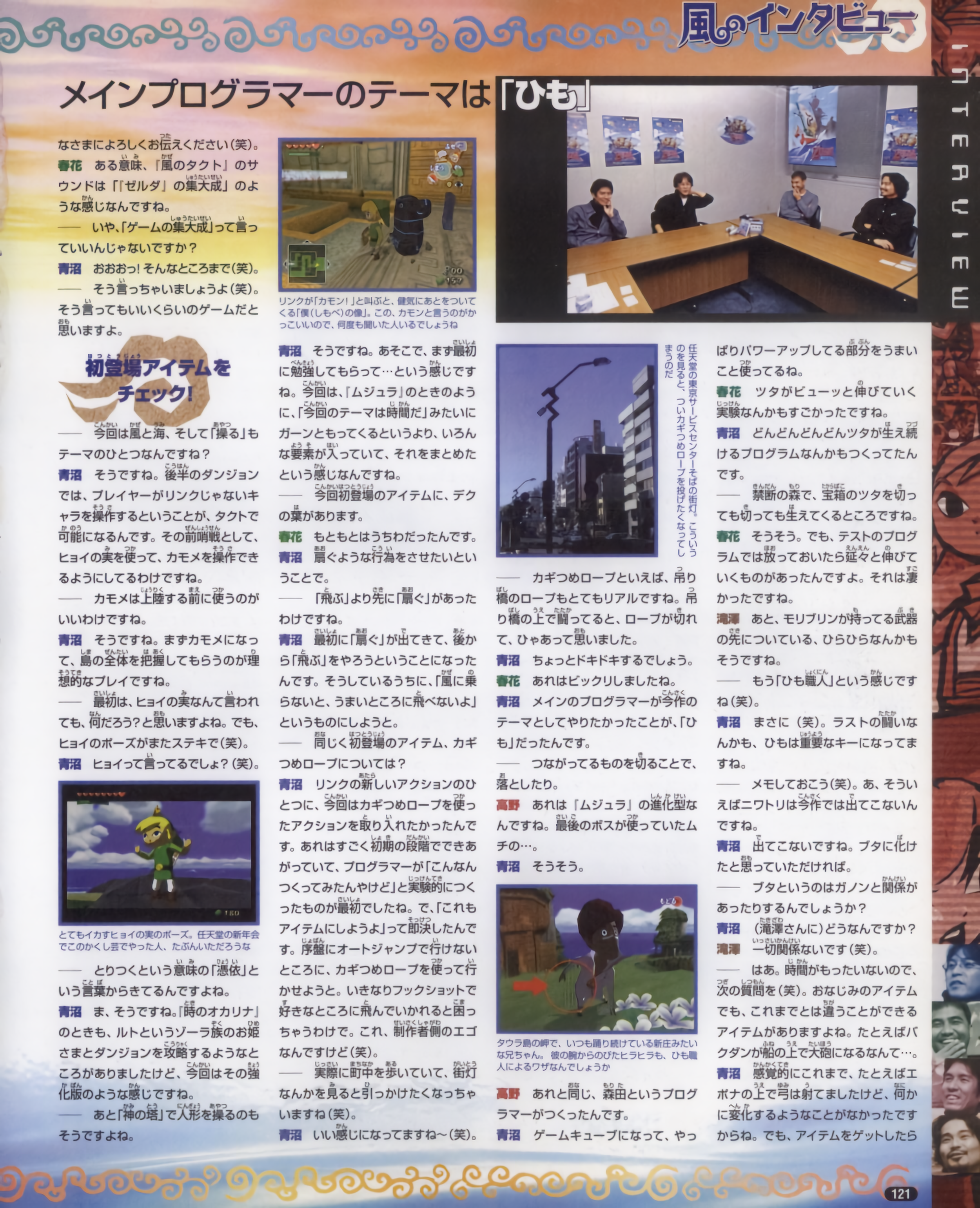

The Legend of Zelda: The Wind Waker - Exclusive Developer Interview
Director: Eiji Aonuma
Born in 1963 in Nagano [prefecture], Nagano [city].
Previous works:
1996 - Marvelous: Another Treasure Island (Super Famicom)
1998 - The Legend of Zelda: Ocarina of Time (Nintendo 64)
2000 - The Legend of Zelda: Majora's Mask (Nintendo 64)
Script and Event Programming: Mitsuhiro Takano
Born in 1967 in Aichi [prefecture], Nagoya [city].
Previous works:
1996 - Marvelous: Another Treasure Island (Super Famicom)
1997 - Star Fox 64 (Nintendo 64)
1997 - 1080° Snowboarding (Nintendo 64)
2000 - The Legend of Zelda: Majora's Mask (Nintendo 64)
Design Manager: Yoshiki Haruhana
Born in 1970, in Osaka [prefecture], Osaka [city].
Previous works:
1996 - Super Mario 64 (Nintendo 64)
1997 - Star Fox 64 (Nintendo 64)
1998 - The Legend of Zelda: Ocarina of Time (Nintendo 64)
2000 - The Legend of Zelda: Majora's Mask (Nintendo 64)
Design Manager: Satoru Takizawa
Born in 1972, in Nagano [prefecture], Ina [city].
Previous works:
1996 - Super Mario 64 (Nintendo 64)
1997 - Star Fox 64 (Nintendo 64)
1998 - The Legend of Zelda: Ocarina of Time (Nintendo 64)
2000 - The Legend of Zelda: Majora's Mask (Nintendo 64)
First there was the sea, on which the boats floated, and then the wind blew...
A sailing ship can go against the wind
Interviewer: In "The Wind Waker", the "wind" and "sea" are important themes, but which one came first?
Haruhana: The sea was first. The first project was to set up the sea as a field [as in "playing field"]. It wasn't until the ship came out that the wind came out. When we had to decide how we should make the ship move, we decided it had to be the wind after all. So we ended up saying, "Well then, let's use the wind more consciously in various places."
Interviewer: How did you end up representing the wind with white lines?
Aonuma: There's a veteran programmer who created similar environmental effects for several successive generations of Zelda games. He made that and showed it to me one day. I thought it was really good, but he made it really casually, so I even said, "Make it even more impressive!" [lit. "put out more bang-bang"]
Interviewer: That's pretty strange. It [that effect] feels like the wind is really blowing.
(Image Caption: You can change the wind's direction with the Song of the Wind. This moment feels so good. Even so, is Zelda the first game to express the wind with white lines?)
Aonuma: It does, doesn't it? If we did too much it became noisy, but doesn't it feel good when it flies by?
Interviewer: It really does feel amazing to watch. But, isn't that kind of white line idea normally difficult to come up with in game development?
Aonuma: It is. I didn't have an image of how the wind should be expressed, so when I saw that programmer making it, I thought, "Ah, this is it!". I thought if we could use that, it would be even better.
Interviewer: Moving on, the two major themes of wind and sea are connected by a ship, right?
Aonuma: That's right. We tried very hard to make the ship Link rides on (King of Red Lions), and there were lots of other things we wanted to do with that. But we didn't have much time, so we ended up with cannons and salvage. A ship feels like a treasure when navigating the sea, doesn't it? Without it, you can't go out to sea. And it would be fun to be able to do various things while on your ship. I've never operated a ship myself, so for the sake of implementing sailing in-game, I read books and such to research. But if the controls were too realistic, it would be difficult to operate with a controller, so I had a hard time figuring out where to draw the line.
Interviewer: Since it's a sailing ship, didn't you just want to preserve the relationship between wind direction and sailing speed?
Aonuma: I used to think that a ship couldn't sail into the wind. Then someone who had actually been on a yacht told me, "If you sail in a zigzag, you'll be able to sail upwind," which was the first time I'd heard of it. I was told, "That's something everyone in America learns in high school, so if you don't do it properly you'll get complaints," and I thought, "I can't let this go, can I?" (Laughing). So in the end, we made it so you can sail into the wind. Miyamoto also asked multiple times, "Is this really something close to how you sail a ship?"
Even the endless sea has an edge...
Interviewer: In the version you showed at E3, there was a ship sailing minigame; you say you can ride the ship in the production version, but I thought it would only be that?
Aonuma: At that point, the ship was still weak. We hadn't made it to the point where you could go back and forth on the ocean completely by boat. The minigame was the first step of development, then we got more and more into the wind and the ship.
Interviewer: When I went out to sea for the first time, I was shocked at how big it is. I could keep going and going and still be in the sea, so at first I thought the software was broken (Laughing).
Everyone: (Laughing).
Interviewer: Continuing through the open sea, and seeing the faint silhouette of an island in the distance... that's something I've never been able to do before, so even if it's just that, "The Wind Waker" is amazing.
Takano: If not for that, we probably wouldn't have been able to create the "miniature garden"-like feel of Zelda.
(Image Caption: Using the C-stick, it feels nice to turn the camera around in front of the ship and have it move backwards, watching the adventure unfold behind you.)
Interviewer: The world is seamlessly connected.
Aonuma: That's what creating the ocean was all about.
Takano: In Nintendo Dream [magazine], a reader asked something like, "Is there a large open area like Hyrule Field in the next Zelda?" and I wanted to answer, "It's even bigger!" (Laughing).
Interviewer: [Laughing]. This must be the game with the biggest world ever (Laughing). Even when the target island is right in front of you, when you see another island, you can't help but want to go there (Laughing).
Aonuma: It piques your curiosity, doesn't it? (Laughing).
Interviewer: I almost forgot to help [Link's] little sister (Laughing).
Everyone: (Laughing).
Interviewer: Also, the feeling of connection between the islands and sea is very well done, it really feels like you've landed on an island.
Aonuma: That was pretty difficult. We couldn't get rid of the bugs right up until release (Laughing).
Interviewer: Was it your goal from the beginning to be able to cross the sea without switching levels?
Aonuma: It was. First and foremost was to be able to go forever without a connection [loading screen], and the size of the islands and the sea came later. To be a little more realistic and talk without dreaming, the reason for the size of the sea is that if we'd made it smaller, we wouldn't have had time to read the data of the island you're about to visit, we were bargaining for microseconds. So the speed of the ship was balanced for that as well.
Interviewer: I see.
Aonuma: During development, when there wasn't much material in the sea, I was bored just running around in the ship, so I said, "Well, let's speed it up!" (Laughing). Then it became impossible to read the data on the way, and things like freezing in various places started to happen (Laughing).
Takano: We were shocked. It was so fast even the sharks couldn't keep up with it (Laughing).
Everyone: (Roaring laughter).
(Image Caption: On the open sea, being attacked by sharks may be annoying, but the seagulls will fly alongside you, which will make you feel a lot better. The music is awesome too!)
Aonuma: Up until now, I've always been conscious of things like that when I'm working, but this time the data fell apart halfway through. In the end, we had to introduce a system that had never existed before, which was quite difficult.
Interviewer: Since it was so large, didn't you hurry to deal with the edge of the sea instead?
Aonuma: In that area, I felt like I could just cut it off and get it over with. The ship can talk and move on its own, so I thought it wouldn't be surprising if it said, "You mustn't go any further." Of course, there was also talk of making a loop where you would come out on the other side if you sailed endlessly (Laughing).
(Image Caption: "To go any further than this would be dangerous!"
What the heck could be up ahead? That mystery will be more clear by the ending.
Takano: But, you can understand the secret of that world by asking "why?" in the ending.
Haruhana: I'm sure you'll understand why the King of Red Lions says "You mustn't go any further."
Interviewer: I'll look forward to that (Laughing). So, are there many islands floating in the sea that aren't required to progress through the game?
Aonuma: No, most are pretty involved. Of course, only a limited number of islands are involved in the main scenario. At the end of the day, there are things you can only get by visiting various islands. So if you do as the King of Red Lions says when he says, "Hurry up and get over there," you might end up saying "Ah!" by the end (Laughing). If you don't do what you're told and take a lot of detours, it will feel like that didn't happen at all.
Haruhana: The more he says "Go over there," the harder it will feel to take a detour.
Aonuma: That's why I really wanted to include, "It's okay to take a detour," in the King of Red Lions' lines (Laughing). Miyamoto also told me he didn't want to be told, "Where are you going right now?" too much, even though the crisis is approaching, I don't think the King of Red Lions would say such a laid-back [/carefree] thing (Laughing).
The mysterious instrument - from theremin to baton
Interviewer: How involved was Mr. Miyamoto in this project?
Aonuma: He wasn't involved in putting the specs together. Not like he was during Ocarina of Time's development...
Interviewer: He really felt like a producer?
(Heading at bottom of the page: Throughout the Zelda series, music has always been essential.)
Aonuma: He did. He played it when he could, and gave feedback like "This part is strange." But, he said a lot about the baton specifically. When I'd more or less completed it, he came to me shaking his head, saying "No, no, this won't do at all," then went to the music manager too and the conversation boiled down to, "So, what should we do?"... That happened about 2-3 times before we settled on its current shape.
Interviewer: When he said it was no good, what were the reasons?
Aonuma: Mostly operability, or "do you really expect the players to do that?" or such. When it comes to how you want people to play, even if it's just shaking a baton, there are a lot of ways to do it. Oh yeah, and it wasn't a baton at first. It was a theremin.
Interviewer: Theremin? That one that makes music without touching it...?
(Image caption: A website introducing the movie "Theremin". Here, you can experience a virtual theremin. [dead URL])
Aonuma: That's right. By doing it like this with both hands (he makes a stroking gesture with his palm facing down), you can change the sound. At the same time we were proposing this project, a movie dealing with the theremin came out... It was something like "That's interesting, I wonder if we can use it?", so I started experimenting, but narratively theremin is... (Laughing). And it's not a common instrument. During Zelda's development, we often replace the initial idea with something else, so while we were exploring various things, we ended up saying, "Wouldn't a baton be good?". One of the game's keywords is "wind", and we thought that "wind" and the action of "swinging" would go well together. So we started making it from the premise that you could control the wind to some extent, then to where you could learn and play the Song of the Wind, but even then Miyamoto rejected it, and we amended it about 3 times.
Interviewer: Was it always played with the C-stick?
Aonuma: At first, I tried to make it use both sticks... it's a remnant of the theremin, which is played with both hands.
Interviewer: I see.
Aonuma: I also agonized over which one to keep. Baton or theremin, or maybe mix the two and create something that hadn't existed before, but I couldn't decide. So I made a snap decision to go with the baton, and it became what it is now.
Interviewer: It may have also been difficult for people to operate this, right?
Aonuma: We thought about that a lot as well, at one point I summarized it to Miyamoto as "it's this line". But once you get used to it...
(Image caption: When using the baton, it may be better not to look too much at the metronome at the top of the screen. Learn the tempo and move the C-stick.)
Interviewer: That makes sense. At first I was seriously watching the metronome at the top of the screen, but as I got used to it, my fingers learned the rhythm and I could swing it smoothly.
Aonuma: In that respect, I think we reached a level of "Ocarina"-like operability. But I think if we'd had more time, we could've made it even easier to use. It's very difficult to match the movement with the sound. I was fine-tuning that area until the last second, but it feels like there are still a few difficult parts left.
Interviewer: It being so difficult is exactly why it feels good when you get it right, and you feel a sense of accomplishment when you finally get to use it. Anyone can make a sound pushing buttons on the ocarina, but there's an "analog" feeling to the possibility of the baton failing.
Aonuma: The two were pretty similar until about halfway through (Laughing).
Interviewer: It might have become "Theremin of the Wind" (Laughing).
Can’t play without music
Interviewer: Not just the melodies you can play with the baton, but the music that flows throughout the entire game is very nice.
Haruhana: It is, isn’t it?
Takano: All the music staff from Joukai (Information Development Headquarters) were mobilized to create it, with Koji Kondo at the head.
Takizawa: The music makes the game feel really tight [as in “lean, well-formed”].
Aonuma: There was one time when I was debugging a bug that caused all the music to skip. I couldn’t fix it for an entire day, and had to debug all day without music. (with feeling) It made me feel sick! (Laughing). At one point I seriously though maybe this game was no good (Laughing). Well, it wasn’t quite when we were on the verge of completion, but it was about the time that I had to start being serious [lit. “firm”]. So that whole day I was like, “Ahhh, I might not be able to do this anymore…”. But the next day, the music came back all of a sudden, and those dark feelings were blown away. It turned out the music was really important (Laughing).
Interviewer: It really does have power. The theme of the sea is especially good.
Takano: It makes you feel like you’re on an adventure, right?
Haruhana: That theme song was used as the background music for the yacht stage we demoed at E3, right?
Takano: That’s right. Since such an epic song was used in the minigame, I thought, “This is a gorgeous minigame.”
Everyone: (Roaring laughter)
Aonuma: Originally, I had imagined wanting a heroic song playing when you were on the sea. That song was made to feel like it inherited from the main theme songs of previous Zelda games. When that song was completed, I had a real feeling that “Ah, we really are making a fun Zelda game.”
Interviewer: Did you include live performances in the sound this time?
Takano: No, everything was made on a computer.
Aonuma: It’s been really well made lately (Laughing).
Interviewer: The familiar songs from Ocarina of Time, like the shop, are the same, right?
(Image caption: Beedle’s [lit. Teri’s] shop, where you can buy hyoi fruits and other goods. A very nostalgic song is playing here. This small boat also has a hammock, which gives a clue to the shopkeeper’s lifestyle.)
Aonuma: It isn’t exactly the same. Of course, I remade it for the Gamecube version, but considering the game’s story flows out of Ocarina of Time, I used some of the same melodies as that production. So there will be a lot of moments where users who played Ocarina of Time will get a good chuckle.
Takano: Even for us, when songs from the series’ past are occasionally included, we get a grin out of it.
Aonuma: That’s right, this time we also included some songs from A Link to the Past [lit. Triforce of the Gods], didn’t we?
Takano: When I listened to the background music playing in the opening cutscene, I went “Oh, A Link to the Past,” when it changed in the middle to panning. When I hear that kind of thing, even if it’s a bit self-flattering, it makes me think just how good the sound team are.
(Heading at bottom of page: The Wind Waker feels like the culmination of the series.)
(Heading at top of page: The main programmer’s theme was “strings”.)
Interviewer: I agree. Please pass on my thanks to the sound staff (Laughing).
Haruhana: In a way, The Wind Waker’s sound feels like the culmination of the whole Zelda series.
Interviewer: No, isn’t it better to say “the culmination of gaming”?
Aonuma: Oh! You’d go that far? (Laughing).
Interviewer: I did say it (Laughing). I feel like it’s a game worth saying that about.
Check out items appearing for the first time!
Interviewer: This time the themes include not just “wind” and “sea”, but also “manipulation”, correct?
Aonuma: That’s right. In the latter half’s dungeons, players will control characters other than Link, which is made possible by the Wind Waker. As a prelude to that, you can use hyoi fruit to control seagulls.
Interviewer: It’s best to use it before the seagulls land, right?
Aonuma: That’s right. The ideal way to play is to become a seagull first and get an overview of the island.
Interviewer: When the hyoi fruit was first mentioned, I thought “What is this?” But the pose Link strikes is also great (Laughing).
Aonuma: It looks like he’s saying “hyoi”, right? (Laughing).
(Image caption: A very cool hyoi fruit pose. There was probably someone who did this pose at Nintendo’s New Years party.)
Interviewer: The name “hyoi” comes from the word “possessed” [憑依 “hyoui”], right?
Aonuma: Well, yes. In Ocarina of Time too, there was a section where you conquered a dungeon with the Zora tribe’s Princess Ruto, and this is meant to feel like an enhanced version of that.
Interviewer: You also control dolls at the Tower of the Gods, correct?
(Image caption: When Link shouts “Come on!”, the Servant Statue follows. It feels cool to say, so some of you have surely heard it a lot.)
Aonuma: That’s right. That place has a feeling like “let me study this first”. This time, unlike in Majora’s Mask where it felt like “this one’s theme is ‘time’”, there are various elements in it, and it feels like it’s all put together.
Interviewer: The Deku Leaf is an item appearing for the first time.
Haruhana: Originally it was a fan.
Aonuma: I wanted to have you use it by moving the controller like a fan.
Interviewer: So before it was used for flying, it was a fan?
Aonuma: It started out as a fan, then became something used for flying later on. In the process, I tried to make it something that says, “If you don’t ride the wind, you can’t fly to a good place.”
Interviewer: What about another item appearing for the first time, the claw rope?
Aonuma: One of the new actions we wanted to give Link this time is to use the claw rope. It was completed at a very early stage, and it was the first thing a programmer made experimentally and said, “I tried this”. So I made a quick decision of, “Let’s make this an item too.” The claw rope lets you get to places in the early stages that you can’t get to using the auto-jump. Being able to suddenly fly to wherever you like with the hookshot caused problems, so this is a bit of ego on the authors’ side (Laughing).
Interviewer: When I was walking around town and saw streetlights, it made me want to hook onto them (Laughing).
Aonuma: It feels good, right? (Laughing).
(Image caption: A streetlight near Nintendo’s Tokyo service center. When you see things like this, you suddenly can’t help but want to use your claw rope on it.)
Interviewer: Speaking of the claw rope, the ropes on the suspension bridges are also very realistic. When fighting on top of one, I thought I was going to cut one.
Aonuma: It definitely makes your heart race a bit.
Haruhana: That surprised me.
Aonuma: The lead programmer wanted one of the themes of this project to be “strings”.
Interviewer: Cutting things that are connected and dropping them?
Takano: That was an evolution from Majora’s Mask. Like the whips the last boss makes…
Aonuma: Yeah, those.
(Image caption: At the cape of Taura Island, there’s a man who looks like Shinjou [likely referencing 新庄剛志 “Tsuyoshi Shinjou”, a well-known Japanese baseball player] who’s always dancing. Is the cloth fluttering from his arms also a trick designed by the string craftsman?)
Takano: Both of those were made by a programmer named Morita.
Aonuma: The power-up from moving to the Gamecube was definitely part of making such great effects.
Haruhana: We also experimented with ivy growing, which was amazing to see.
Aonuma: The way it was programmed made the ivy continue to grow like crazy.
Interviewer: In the Forbidden Forest, the vines around the treasure chests seem to keep growing no matter how many times you cut them.
Haruhana: Yes! But in the test program, it would grow endlessly if you left it alone. That was incredible.
Takizawa: The same goes for the fluttering cloth on the ends of Moblins’ weapons.
Interviewer: It almost feels like they’re a “string craftsman” (Laughing).
Aonuma: Exactly (Laughing). Even in the final battle, strings are an important key.
Interviewer: I’ll note that down (Laughing). Ah, come to think of it, chickens didn’t appear this time around.
Aonuma: No, they didn’t. You’re welcome to think of them as disguised as pigs.
Interviewer: Do the pigs have any connection to Ganon?
Aonuma: (To Takizawa) What do you think?
Takizawa: Definitely not related (Laughing).
Interviewer: Ahh, it looks like we’re running out of time, I’ll have to move to the next question (Laughing). Even though there are some familiar items, even those seem to be able to do different things. For example, bombs turning into cannonballs when on your ship…
Aonuma: Intuitively, you were able to shoot a bow while riding Epona, for example, but it didn’t really change anything. But when you got a new item, we put in hints like “you can also use this while on your ship” and such.
(Heading at top of page: Do your best to save your family!)
Interviewer: I didn’t read those (Laughing).
Aonuma: You’ve gotta take your time playing! (Laughing).
Takano: We tried our best to think of and write that text! (Laughing).
Interviewer: For the sake of this interview, I had to play quickly! (Laughing). I didn’t really intend to skip it (Laughing).
Aonuma: Since you can fire cannons from your ship this time, compared to before it’s even more important to carry bombs.
(Image caption: Beedle’s [lit. Teri’s] ship, belching smoke. A few moments after this, it disappeared to the bottom of the sea with a large pile of hyoi fruit… well, that didn’t actually happen, though.)
Interviewer: Can you aim and fire at Beedle’s ship…?
Takano: It even properly emits smoke.
Interviewer: When it comes to today’s game’s story, I get the impression that it has been very well thought out. Was there a pre-planned scenario/story thought of ahead of time?
Takano: When it comes to the world of the Legend of Zelda, “The story is good” or “How is the story?” is said. However, when it comes to actually creating the games, Miyamoto and Aonuma both say that the story isn’t the core of the game. In the world of Zelda that story that takes place is a common royal tale. The story isn’t necessarily the important thing, but when we think of Zelda’s world the cast of characters is what we think about. We decide one by one what each character is going to be like and from that result the world of Zelda is made. That’s our thoughts on the story.
Interviewer: I’ve been playing this series for a long time, so I understand that type of thing, but this time it feels as though the story was decided on rather quickly.
Haruhana: That’s right, the story of Link’s sister being kidnapped was decided quite early on.
Aonuma: For the main scenario, we discussed what kind of Zelda game we wanted to make early on and came up with some ideas about Hyrule being sealed at the bottom of the sea as well as the Master Sword being powerless. But still minor nuances changed during development. So, when it came to the setting, I asked myself why the sea? Well, I wanted to completely smash Hyrule as we know it once and for all because I thought there’s no point in just remaking the same Hyrule from the N64 games again. So, I thought “what should we do?
Let’s sink it!” (Laughs)
All: (Hard laughter)
Aonuma: It’s a pretty destructive way of deciding (Laughs). At the beginning, we had a plan to make a game that was like A Link to The Past where you travelled back and forth between the past and the present versions of Hyrule, however the limited development time forced us to change our plans. So even though we originally had a more complicated idea in mind, we thought it was best to just keep the story smaller and still have Link’s fate be determined by his journey to Hyrule at the bottom of the sea. I like to think that the story didn’t change much from that first line of thought.
Interviewer: When I heard the game would take place in the sea, I wondered if there would be some sort of conflict between Hyrule and other worlds but seeing it like this made a real impression on me. Thanks for letting it sink in! (Laughs)
All: (Hard laughter)
Interviewer: In any case, the salvaged treasure chests, are Hyrule’s treasures then?
Aonuma: Yes, that’s right.
Interviewer: It’s a considerably long rope on the crane! (Laughs)
Caption: Putting aside the fact that a small boat like the King of Red Lions houses an entire salvage machine, Link’s face when he gazes upon the treasure is so cute!
Aonuma: My sense of depth is fairly vague…(Laughs) When you go to Hyrule, you will quickly learn the sense of depth for yourself. There’s a certain depth that people in Hyrule can touch, so I guess the rope goes a bit deeper than that.
You want to save your family more than the princess.
Interviewer: Why is it, that your younger sister gets kidnapped nearly right away?
Takizawa: The keyword is “Link’s family connection”.
Interviewer: Because up until now we haven’t been able to meet any of Link’s family?
Takano: In the past games, the story starts suddenly with a young boy who is thrown into saving a world on the brink of destruction, doing his best to defeat the enemy. In Ocarina of Time, Link works incredibly hard to save the world all for Princess Zelda to tell him “It’s your fault all this happened, go back!” What was the point of even trying?! (Laughs). I tried thinking of things that would make me emotionally invested in the game, and I thought that if I needed to save my family, I would somehow figure out a way.
Takizawa: As for the motivations of this adventure, we wanted to try something different than what we have done before.
Haruhana: In the past we were told, “It’s the day of adventure!” and we surprisingly asked “Oh, is that so?” (Laughs). For me personally, I think that the idea of being a young boy asked to go on an adventure is very exciting! Normally a 12-year-old boy isn’t told “This is your destiny” but when someone he cares about has disappeared, I think they would try their hardest to save them.
Interviewer: It seems like that more ordinary theme is reflected in the thought behind the shield’s simple design then.
Haruhana: In my mind, like I said before, he’s just a normal young boy. So, for example, when I’m designing items like a hammer, I’m not thinking necessarily its appearance needs to be cool looking. Rather, I’m thinking “it’s a weird hammer, but let’s use it anyway”
Interviewer: So, the motivation has been raised because of the desire to save family and not the unknown princess?
Haruhana: That’s right.
Takano: Miyamoto was very particular when it came to the telescope item at first...
Aonuma: He said something like “How would you get an expensive present like a telescope from your younger sister for your birthday?” (Laughs)
All: (Hard laughter)
Interviewer: Oh wow, going into the extremely fine details. (Laughs)
Aonuma: Besides, if we had set it up that your sister had two telescopes he would have said “Why does your sister have two telescopes?” (Laughs)
Takano: They said so much about this topic that I thought, “I wonder how much you care about this?” I asked, “Well what about lending it to your brother? Is that okay?” (Laughs)
Aonuma: So that’s why the beginning of the story’s parts changed secretly.
Interviewer: Is it possible for a younger sister to send her brother her allowance in a sealed letter? (Laughs)
Takano: (To Aonuma) What’s that mean?
Aonuma: I have nooo idea (Laughs)
Takano: But it’s money that my sister worked hard to save, so it’s probably better than buying and sending things normally.
Interviewer: But if it’s going to be that way, I would want about 200 rupees at best. (Laughs)
Takano: I can’t give that much (Laughs)
Interviewer: While working hard to save my family, I was surprised to see how quickly my grandmother recovered from her illness. (Laughs)
Aonuma: After all, fairy power is amazing! (Laughs)
Interviewer: Sturgeon would talk about Fairy Powder, right? I thought if I brought fairies to him, he would turn them into powder. But my request just made him spin around so I said “Is that so? Well, if grandma recovers that quick, it won’t be much of a game, so grandma must wake up at the end of the game”. Then I saw another staff member with a bowl of Grandma’s Soup and asked, “What’s that?” (Laughs)
All: (Hard laughter)
Aonuma: That’s overthinking (Laughs)
Toon Link’s eyes don’t talk, they meow (In Japanese Toon Link’s name seems to be Cat-eye Link hence the pun)
Interviewer: I get questions like this from readers all the time. (Laughs) But I must ask, why don’t the characters in Zelda speak?
Aonuma: Ahh, why of course…Well I would say that Zelda doesn’t really need that kind of thing.
Interviewer: The N64 version of StarFox has him talking quite often because he is busy shooting and there’s no time to read the text on screen, while in Zelda’s case the text is meant to be read meticulously.
Aonuma: This time, we have the GameCube, so it’s possible to use large amounts of data and someone asked me “Is it possible to use voice acting this time?” and without hesitation I responded “No” (laughs)
Takano: We have hundreds of people working on this game, each with their own image of each character so if we add voice acting everyone would say “This is different than what I expected”
Haruhana: Yes, if we add voices, people will say it‘s different than what they imagined.
Interviewer: But the old man Salvatore on Windfall Island with the sinking ships game goes “Pshun, Pshun, Boom!” or something like that so it would be nice to hear voiced.
Caption: The man who runs the ship sinking game usually looks bored, but when the game starts, he gets very serious! Is this what professionals are? (What’s on that poster behind him?)
Aonuma: On the contrary, it feels like they’ve come alive! Overdoing it is easy, so it’s good to be a bit more rigid with it.
Haruhana: One thing I can say is that when they do talk, I personally find it difficult to be receptive to their emotions. If a character on screen gets all excited and says, “This is the way I am!” the player might react coldly to that, I think.
Interviewer: Ah, I see. I guess it can also be quite tiresome to have to hear the same line spoken repeatedly, even if it’s just text.
Takizawa: I also don’t want the text to be click through quickly. (Mashed)
Interviewer: But, because its continuously not spoken, certain words have a longer lasting effect. The pirate’s “Oh-ho-ho!” upon acquaintance or Link’s “Purring” when he cries (I assume the sound he makes when he rolls mimics the onomatopoeia for cats in Japan nya) (Laughs)
Takano: Up until the other day I didn’t know that. (Laughs)
Caption: This is the daughter of former millionaire who works as a part-timer hawking goods. If you follow her at night, you can hear Link’s cute purr.
Aonuma: In addition to Takano, there is another planner named Takahashi. These minor details are often worked on in a very lively environment so when I heard the meow [nya] I was surprised (Laughs). The Zelda series has this feeling of progressively solidifying ideas so It’s not like we’re always saying, “You can’t do that!” instead trying to foster an environment to nurture ideas to fruition. Only when we’re veering off the path too much is when we have a discussion around it to clear things up. So, in this way, everybody can feel comfortable to bring ideas forward. After all, each person has a different feeling when it comes to Zelda.
Interviewer: Moving on, do you have a favourite character (From Wind Waker)?
Haruhana: Yes of course, for me recently I like Medli.
Takizawa: Recently huh? (Laughs)
Haruhana: The Nintendo Gallery is also great huh? But while I’m playing, I prefer Medli.
Interviewer: The forest fairy (korok) Makar is great too.
Haruhana: Makar and Medli are competing to see who’s in charge, so they’re both important characters, so you’ll have to play the game until the end to see what happens.
Image Caption: The Harp playing Medli and the Guitar playing Makar. Which do you prefer?
Aonuma: The Team Medli and Team Makar groups are competing, so we’ll see who get evaluated better. (Laughs)
Haruhana: That’s better said.
Takano: I said I won’t let that happen. (Laughs)
Takizawa: The new female players were saying “Makar is so cute!!” (Laughs)
Haruhana: Hmph! (Laughs)
Interviewer: I imagine the male players love Medli. (Laughs)
Takizawa: She is a girl after all! (Japanese female honorific used here to denote gender)
Haruhana: Not sure why were call her Medli-chan. (Laughs)
(Heading at top of page: The Legend Of Zelda continues)
Takizawa: Especially because she was created by two of Nintendo’s most rigid designers. (Laughs)
Interviewer: Beetle is also good.
Takano: Thank you!
Interviewer: But again, we have a frequently asked question from our readers: “Why do Beetle’s underwear/pants have a Rhino beetle on them?” (Laughs) (In Japanese Beetle’s name is Terry)
Haruhana: Even I don’t know (Laughs). The person in charge put it there.
Caption: Beetle gives a point card where you can earn “Praise Points”. I’m seriously considering making the pants he’s wearing a “service project” for all readers.
Interviewer: Even if you wanted to put it on them, why a Rhino Beetle? (Laughs) I guess Link also starts off wearing a lobster shirt though.
Takano: Everybody’s got something different, for example the young man on Dragon Roost Island who’s always restless. Later, he’s delivering mail and his bag seems to have a snail on it.
Interviewer: I wonder if items emblazoned with living creatures are trendy on those islands. (Laughs)
Marvelous, another The Wind Waker
Interviewer: The Wind Waker and Aonuma’s Marvelous Another Treasure Island (1996 Super Famicom) are games that share the same scent.
Aonuma: I can’t shake off my roots, no matter how much time has passed I always end up doing the same thing repeatedly. A different person oversaw the story for Ocarina of Time and in Majora’s Mask I was just building off Ocarina’s base. However, this time it’s my first time creating an original Zelda story so I have feelings of wondering about if it’ll be okay or if I can do whatever I want? (Laughs)
Takano: This is kind of Aonuma’s world (Laughs)
All: (Hard laughter)
Aonuma: There’s been no growth whatsoever (Laughs)
Takano: This time as well until talking about the tone of voice, this seems like the original lines in Marvelous huh? I better make a revision to that to differentiate them. The stories resembled each other in parts, but I felt that with Wind Waker he was writing with great energy.
Aonuma: Of course, I don’t force anyone to do anything. (Looking at the staff members on each side of him) Because it’s impossible to do all this on my own, I am always asking “This is okay right?” (Laughs)
Image Caption: The same year the N64 went on sale, Marvelous went on sale for the Super Famicom (SNES). Aonuma was the director and Takano worked in charge of supporting staff.
Interviewer: Mr. Aonuma when you worked on Marvelous, did you say, “I like Zelda, but I’m going to do things you can’t do with Zelda in Marvelous?”
Aonuma: After all, we’ve been together for a long time. (Him and Takano) What we couldn’t do in A Link to the Past we did with Marvelous and likewise on when it came to the N64, we did with games like Ocarina of Time what we couldn’t do with A Link to the Past.
Interviewer: Oh, please let us know if there were any ideas that were thought of during development to surpass the previous game’s ideas but in the end had to be cut due for the production schedule.
Haruhana: Sure, I guess we managed to fit quite a bit in.
Aonuma: Mostly all of it made it in huh.
Takizawa: The cut content is only like the crabs, right?
Interviewer: Crabs? (Laughs)
Aonuma: That’s right! The crabs! (Laughs). The crabs along the beach, we had wanted to do various things with them but, (looking frustrated) we were unable to! We thought “What can we do with the crabs” and then development finished. (Laughs)
Takizawa: One of the programmers said, “Maybe we can make them 10 times as large for now?” (Laughs)
Interviewer: Maybe, Zelda fans from across Japan are going to be trying many things on the crabs now to see what they can do (Laughs)
Caption: Crabs make frequent appearances on the beach. Players were probably looking forward to catching them or seeing the effect of bombs on them to see what would happen.
Aonuma: I apologize about the crabs (Laughs)
Takano: That thing looks exactly like a teacher’s scarf (Laughs)
Interviewer: Marvelous’s scarf of course. It has meaning but not for me (Laughs)
TITLE: Going beyond the hard and painful times
Interviewer: What does Zelda mean to all of you?
Aonuma: When I’m making Zelda I think “Why am I doing this difficult thing again?”. But once it’s finished, I often think a little bit about what’s next. But for once, I wonder if I won’t think about what’s next (Laughs). Cause when I was making this game, it was so difficult at times that I wondered why I even decided to make a game like this. But because it was amazing when it was over, I’m glad I did it. I’m not a fan of this kind of thing (Sarcastically laughs)
Takano: During development truly is grueling, isn’t it?
Interviewer: But surely there were enjoyable things about it?
Aonuma: But for Takano, during the final stretch he couldn’t go home (Laughs).
Takano: I really couldn’t…
Haruhana: Couldn’t see your kids (Laughs).
Takano: The security guard was experienced and when I was left alone at midnight he would still say “Hello there” cheerfully to me (Laughs). When everyone would arrive in the morning, I would go from where I slept on the third floor to my work area on the fifth floor, and at midnight would return to my life on the third floor. I had no idea what the weather or conditions were like outside.
Aonuma: Suddenly it had become colder outside (Laughs).
Takano: Yes (laughs), I was the only person wearing short sleeves in the entire company. Even though everyone was wearing coats (Laughs).
Aonuma: I’d be like what is going on with the people wearing the down jackets? (Laughs) If I returned home, I was surprised to feel how cold it had gotten.
Takano: Even though it was so painful, in the end we had finished it and played it endlessly. While playing, I thought “This isn’t too bad if I say so myself” (Laughs)
Aonuma: This is a game that absorbs anything. This isn’t like the previously discussed sinking ships mini game; anything can be in this game. That’s why it’s so hard to create. Furthermore, like I was saying before about Zelda, there are so many things I didn’t know before, but while I was playing, I felt like I was still able to play with an amazement, even though I was the one who had made it.
Interviewer: After all this, onto the next one?
Aonuma: Ha-ha no, the next one (looks at the other three staff while explaining) will be left up to these guys.
All: (Hard laughter)
Aonuma: My Zelda is complete. No more, no less.
Takizawa: It appeals to someone right? (Laughs)
Aonuma: (While looking at the roof) Someone in this area…(Laughs)
Interviewer: (Laughing). Haruhana-san, for you what does Zelda mean?
Haruhana: A game is something you can touch so, especially Zelda is something that can do anything, and responding to anything. Zelda is something I’m always thinking about and even when I play the past games I think “What is this?”
Aonuma: Because you’ve always been working on the series, I think he’d like to be on the flip side and just be able to play the game.
Takizawa: For me because I love A Link to the Past, I want to feel how it felt to play back then. I want to do it but when I think about doing my best to make it… to put it in serious terms, for me it’s about surpassing the achievements of A Link to the Past which as I said is a game I adore. So, I guess for me, Zelda is something that should be surpassed. (Laughs)
All: So cool! (Laughs)
Interviewer: Has it been surpassed this time?
Takizawa: For me, it’s something that will always be unable to exceed, but I’m always trying my hardest to make something that will surpass A Link to the Past.
After the end, a second round!
Interviewer: By the time this article goes on sale, I think many people will have already reached the ending of the game. What did you think of adjusting this game’s difficulty this time around?
Aonuma: Miyamoto was adjusting the game until the very end so that everyone could reach the end.
Interviewer: I felt that the boss was a bit easy to beat.
Aonuma: In previous fights, the number of times you had to hit the boss was very important, wasn’t it? This time, we decided to omit those extra moments that stretched out the game so that just the most exciting parts of the game can be experienced while not having to worry about the difficulty of each fight so much. There will probably be people who think it’s too easy, but the world of Zelda is more than just difficult boss fights. In many cases, only a small number of players will get the opportunity to interact with all the elements in the game, but this time we’ve aimed to create an experience that allows more players to see and play with all the ideas to the fullest. With Ocarina of Time, I received a lot of feedback from players who said they felt stuck due to the dungeons, but I wanted people to experience the game till the end. I would say we have carefully adjusted the difficulty in The Wind Waker so that anyone can complete it. To get to the end, we have also implemented the GB Tingle system, so please try to play till the end.
Takano: There’s even more to do after the ending…
Interviewer: What? Are you sure it’s not the Betrayal Baton? (Pun on Wind Waker’s Japanese name)
All: (Hard laughter)
Aonuma: There is a common event where in Zelda games if you do the same sub-events, you can get all sorts of different item-like things. The game is packed full of things to do, so we think that it will take a lot of time to try completing them all.
Haruhana: It would be quite difficult to do all in one go.
Aonuma: So, this time, things like the sub-events will require you to do them multiple times to unlock all the items.
Interviewer: Ah, so after you’ve cleared the game, you can continue using the same save file. That’s wonderful!
Aonuma: Of course, the telescope, bottles and items such as these will be lost until you get them again, but the necessary items needed for the events will remain the way you had them in the first playthrough.
Interviewer: So, some things are only possible on the second playthrough?
Aonuma: Of course, we’ve prepared that as well, meaning the value of the second playthrough was constantly being thought about while we made the game. We spent a considerable time deliberating about that with many people.
Interviewer: After Ocarina of Time came out, Majora’s Mask followed, and many people were pleased. Are there any plans for a The Wind Waker 2?
Aonuma: (Indicating towards the other three staff) So they…. (Laughs)
Haruhana: Why are you looking this way?! (Laughs)
Aonuma: Well maybe it’s possible. But who makes it will be a different story.
Interviewer: With this, it seems like TV Animation will become obsolete.
Haruhana: Thank you very much.
Interviewer: So, it seems that The Wind Waker isn’t the end. I wonder if another will be made on the same system.
Aonuma: If you think about such things easily, you’ll come to regret it later. (Laughs)
For any feedback or to just join the community, jump into our discord: https://discord.gg/T8Gn62Jr








